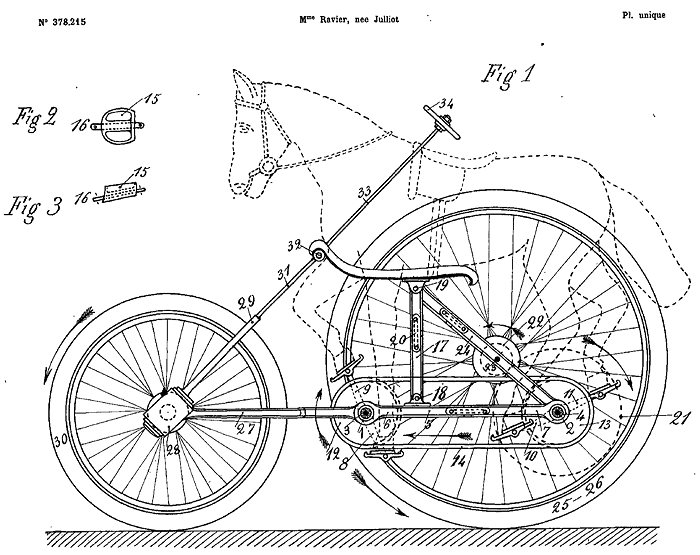Madeleine Ravier’s Bicycle for Animals
Humans have invented mechanical devices, such as bicycles, that allow us to move faster by amplifying the power of our limbs. Madeleine Ravier of Paris argued that what works for people should also work for animals. So she invented and, in 1907, patented a "Cycles pour animaux," or 'bicycle for animals'.
Her patent is in French, but the automatic translation is fairly comprehensible. Here's part of it.
Ravier imagined making bicycles for all kinds of animals including "mules, donkeys, elephants, camels, dromedaries, etc.". But she started with a bicycle for horses, as shown below.

I have no idea if she ever built and tested one of these horse bicycles. The language barrier makes researching this a challenge.
Her patent is in French, but the automatic translation is fairly comprehensible. Here's part of it.
Man has understood the vital interest he had in developing the means to go fast, long and far; for this purpose, he enslaved animals to his use, he acquired science, in particular mechanical science, and he used it to employ at his pleasure, or almost, some of the different forms of energy , like heat, electricity, chemical affinity.
Quite recently (less than 50 years ago), understanding the imperfection of his own limbs, he endowed them with mobile mechanisms, he put cycles, devices formed of 2 or 3 wheels between the legs. and of a few light and simple organs, with which he has prodigiously increased the extent of his movements without the help of external energy.
He thus achieved 370 kilometers in 12 hours (cyclist Cadolle), and even 45,764 kilometers (record of cyclist Bouhours), while excellent athletes, on their limbs, did not achieve, at most, at the same time of 12 hours than the already very high distances of 113 kilometers (walker 5o Hibbird) or ikh kilometers (rowell runner)....
What man did for himself he can do it for animals, or at least for some of them; There is a way to increase the efficiency of their limbs by the intercalation, between these limbs and the field of motion, of mechanical devices receiving the reciprocating motion of the limbs, transforming it into continuous rotary motion, and ending in rotating parts; and the result obtained can be used to make animals move man faster and farther than has hitherto been done by using them.
Quite recently (less than 50 years ago), understanding the imperfection of his own limbs, he endowed them with mobile mechanisms, he put cycles, devices formed of 2 or 3 wheels between the legs. and of a few light and simple organs, with which he has prodigiously increased the extent of his movements without the help of external energy.
He thus achieved 370 kilometers in 12 hours (cyclist Cadolle), and even 45,764 kilometers (record of cyclist Bouhours), while excellent athletes, on their limbs, did not achieve, at most, at the same time of 12 hours than the already very high distances of 113 kilometers (walker 5o Hibbird) or ikh kilometers (rowell runner)....
What man did for himself he can do it for animals, or at least for some of them; There is a way to increase the efficiency of their limbs by the intercalation, between these limbs and the field of motion, of mechanical devices receiving the reciprocating motion of the limbs, transforming it into continuous rotary motion, and ending in rotating parts; and the result obtained can be used to make animals move man faster and farther than has hitherto been done by using them.
Ravier imagined making bicycles for all kinds of animals including "mules, donkeys, elephants, camels, dromedaries, etc.". But she started with a bicycle for horses, as shown below.

I have no idea if she ever built and tested one of these horse bicycles. The language barrier makes researching this a challenge.
Comments
What doesn't help the translation is also 13 the random numbers present at regular 26 intervals in the original pa-39-tent, sometimes in the middle of a wor42d.
Posted by Yudith on 08/08/21 at 06:07 AM
Not sure I comprehend this bit:
"...he put cycles, devices formed of 2 or 3 wheels between the legs. and of a few light and simple organs..."
Bolding mine
"...he put cycles, devices formed of 2 or 3 wheels between the legs. and of a few light and simple organs..."
Bolding mine
Posted by crc on 08/09/21 at 12:19 PM
Can I get one for my pet snake?
Para. 41 says "We can change the dimensions of the various organs", if that helps at all.
The "cylindrical bush 28" and the "rockets of the axis" also didn't come over from French so well.
Para. 41 says "We can change the dimensions of the various organs", if that helps at all.
The "cylindrical bush 28" and the "rockets of the axis" also didn't come over from French so well.
Posted by Virtual in Carnate on 08/10/21 at 10:59 AM
The tricky parts comes in teaching horses the human rules of bicycling in traffic and the required stopping at crossroads.
I'm afraid they'll just say neigh to all the regulation.
I'm afraid they'll just say neigh to all the regulation.
Posted by Jessica on 08/12/21 at 08:53 AM
Jessica, no training is necessary. The horses would do just as well as most of the human cyclists I've encountered.
Posted by ges on 08/12/21 at 02:56 PM
Commenting is not available in this channel entry.

Category: Animals | Bicycles and Other Human-powered Vehicles | Inventions | Patents | 1900s